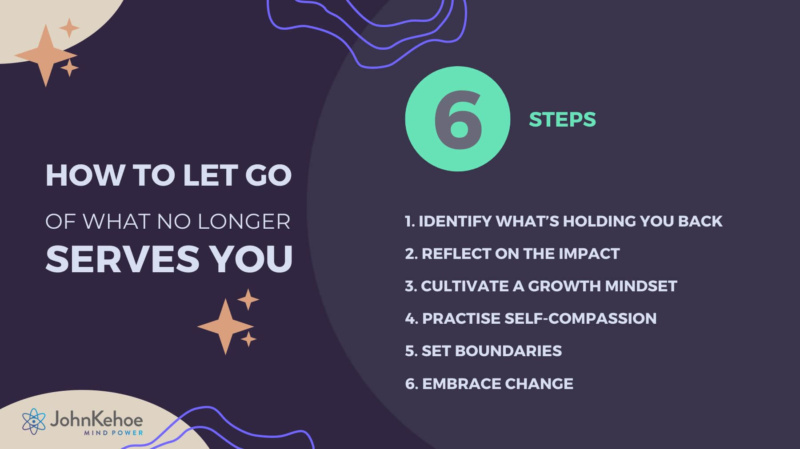As you evolve and seek a deeper understanding of yourself, there’s a pivotal moment when you must confront and let go of what no longer serves you. Like a traveller shedding excess baggage to embark on a lighter, more fulfilling path, you too must release the burdens that hinder your progress.
In this post, you’ll discover strategies for uncovering and letting go of what no longer serves you. This transformative process will enable you to embrace the freedom and authenticity that await you on the other side.
Let’s jump right in.

1. Identify What’s Holding You Back
The first step towards releasing the things that no longer serve you is recognizing their presence in your life.
These chains can manifest in various forms: limiting beliefs, toxic relationships, self-doubt, or outdated habits.
Here are some strategies to help you identify what may be hindering your growth and progress:
- Reflect: Take dedicated time to reflect on your life, choices, and patterns. Look closely at areas where you feel stuck, unfulfilled, or dissatisfied. Consider your thoughts, emotions, behaviours, and recurring situations. Honest self-reflection can reveal patterns and belief systems that may be acting as chains.
- Uncover limiting beliefs: Pay attention to the thoughts and beliefs that arise when you face challenges or pursue your goals. Do you notice recurring negative thoughts or self-doubt? Limiting beliefs often stem from past experiences, societal conditioning, or fear of failure. Identify these beliefs, such as “I’m not good enough” or “I don’t deserve happiness,” as they can hold you back.
- Assess relationships: Review your relationships and their impact on your well-being. How do you know a relationship no longer serves you? Either the relationship uplifts and supports you or it drains your energy and hinders your growth. Toxic or unhealthy relationships can hold you back, preventing you from reaching your full potential.
- Examine your habits and routines: Consider your daily habits and routines. Are there behaviours that no longer align with your values or goals? Do you engage in activities that drain your time and energy without providing any real benefit? Identifying and addressing these habits can help you break free from their limiting effects. By becoming aware of their existence, we gain the power to break free from their hold.
2. Reflect on Its Impact
Take a moment to reflect on how the relationship, the role, or the item you’re trying to let go of has influenced your life. Have they brought you joy, growth, and fulfilment? Or have they caused stagnation, pain, and discontent?
Honest introspection allows you to discover their true value. It paves the way for conscious decision-making.
But examining the conscious mind is only half the battle. You also need to reflect on your subconscious behaviours—the things you do without thinking about them. These automatic behaviours may be impacting the ways you hold onto things that no longer serve you.
Two things that can lead us to discover these behaviours—
a. Past experiences
To bring the faulty program to the surface, dive into your past. Try to identify the experiences, events, and influences that may have shaped your subconscious attachment to the thing you’re trying to let go of.
Childhood experiences, societal conditioning, and significant life events can leave imprints on the subconscious mind.
By tracing back to the origins, you can gain insights into why you may be holding onto them. You need to bring them to the surface to see clearly and then you can begin to discharge the emotion and the hold it has over you.
b. Self-sabotage
Another valuable method to reflect on the subconscious conditioning within your mind is to look for and analyze self-sabotaging behaviours.
How do you do this? In any area of your life where you have problems, you probably have faulty subconscious programming. You just need to follow the footprints.
Reflect on any self-sabotaging behaviours that arise from your contemplations. Do you notice repetitive cycles, missed opportunities, or a lack of growth in certain areas of your life? These patterns can be indicative of how the subconscious programming is impacting your actions and choices.

3. Cultivate a Growth Mindset
To let go of what no longer serves us, we must adopt a growth mindset.
Embrace the belief that change is not only possible but necessary for personal evolution. Recognize that you are not defined by your past or present circumstances but by your ability to adapt and grow. And remember that the universe wants you to succeed.
Imagine if you achieved the goals you set for yourself and how many people it could help in your life. With this mindset, you can approach the process of letting go with optimism and resilience.
4. Practise Self-Compassion
Letting go of what no longer serves us can be emotionally challenging. It is vital to treat ourselves with compassion throughout this process.
Understand that it is normal to feel a sense of loss or uncertainty. Embrace self-care practices such as journaling, meditation, or seeking support from loved ones to navigate these emotions.
One of the first things I share with my students in my 6-week Mind Power training is that when you complete the 20 minutes of exercises, you’re done for the day. You don’t obsess over it or focus all your attention on it. Rather, it’s only a part of your day rather than your entire day.
You must let your daily practice of Mind Power exercises integrate into your subconscious mind.
Remember, you are on a journey of self-liberation and deserve kindness, patience and lots of fun.
5. Set Boundaries
Releasing what no longer serves us often requires setting clear boundaries. By establishing healthy boundaries, you create space for new experiences and relationships that nurture and uplift you.
Identify the relationships, activities, or situations that drain your energy or hinder your growth. Learn to say “no” to commitments that do not align with your values or purpose.
6. Embrace Change
As you let go of what no longer serves you, be prepared for the transformative power of change.
Change is an inherent part of life. Everything in the universe is in a constant state of flux, and resisting change only leads to stagnation and limited growth.
True growth occurs when we step out of our comfort zones.
Holding onto things that no longer serve us often stems from a fear of the unknown or a desire to maintain familiarity. This is where you will want to embrace discomfort, take calculated risks, and venture into uncharted territory. Regardless of how difficult you may tell yourself it may be.
The only person preventing you from becoming the best version of yourself is you. One of the most controversial things I teach in the 6-week Mind Power training program is: “You are the cause of everything that happens to you.”
Why? Well, it’s quite simple. Everything is composed of vibrational frequencies and energy signatures. That’s why you want to expose yourself to the unknown, because who knows what wonderful things you may be introduced to.
Embrace the uncertainty and the unknown, for it is within these spaces that growth flourishes. Allow yourself to evolve, to shed old layers, and to explore new horizons as letting go of what no longer serves us is essential for personal evolution. Each release becomes a stepping stone toward your authentic self.

Conclusion
Releasing the things that no longer serve us is an act of self-liberation and an invitation to embrace a life of authenticity and freedom.
By recognizing the chains, reflecting on their impact, cultivating a growth mindset, practising self-compassion, setting boundaries, and embracing change, we unlock the door to personal transformation.
Remember, it is in letting go that we create space for new possibilities, growth, and the fulfilment we seek.
So, let go of what no longer serves you and soar into a future filled with boundless potential where anything is possible.
